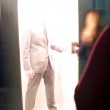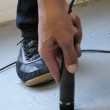by Craig Smith-Dermody
on December 2nd, 2011
Once when I was a kid, I decided to rub two magnets along the surface of my mother’s computer. The technological myth proved true and her hard drive was wiped completely. In similar form, McKeever Donovan’s New Work explores the affective capacities of seemingly empty decorative archetypes. Donovan utilizes this space to provide the simultaneous conception and exploration of a blank slate from which his compositions emerge.

The on-paper layout of the show is as modest as the aesthetic of its comprising works. Small magnets float on the surface of three framed monochromes. A sculpture comprised of metal tubing rests on the floor atop two bath mats. The color options are equally basic. Khaki, indigo, grey, primary blue and red; a dominant presence of utilitarian décor reinforces an investment in aesthetic accountability. Donovan’s this-and-not-that approach to material selection provides a grounds for divorce from the immediate ready-made coding of the hardware store vocabulary, enabling closer engagement with the virtual-rendering capacities of its signified(s). Monochromes and bath mats serve as ground for the material gestures of magnets and tubing. These gestures mark identity and form within their respective decorative grounds, wresting affective impact from formal composition. Continue Reading More »
Comments closed
by Aaron Harbour
on October 27th, 2011

- Fran Herndon, Opening Day, 1961
Catch Me If You Can: A cluster of greyhounds surging into the foreground, muzzled, wearing numbers, chasing a hastily rendered pair of rabbits through roughly sketched grass. On a muted grocery bag or faded newspaper backdrop are other creatures and, in the center, obscured by washes of pale blue, an indistinct crowd. Powerfully narrative, but hazed by the manner of its construction, this image is fugitive. The characters resist any simple one-to-one relation with the viewer who’s personage spreads out piecemeal across the image. There is a spectacle here, echoed in the other collages on display. Continue Reading More »
Comments closed
by Brinson Renda
on October 12th, 2011
The weather during this month’s Wynwood gallery walk ’s was a total drag, but the openings made up for it all. If you couldn’t make it or aren’t in the Miami area here’s a quick re-cap!
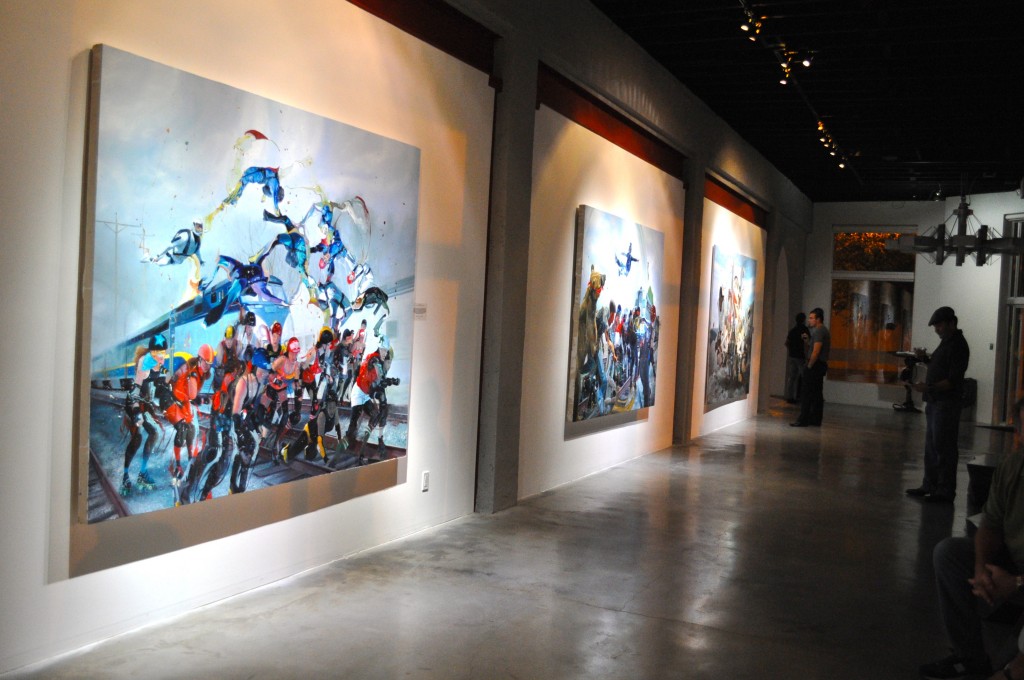
101/exhibit
Continue Reading More »
Comments closed
by Brent Birnbaum
on October 11th, 2011
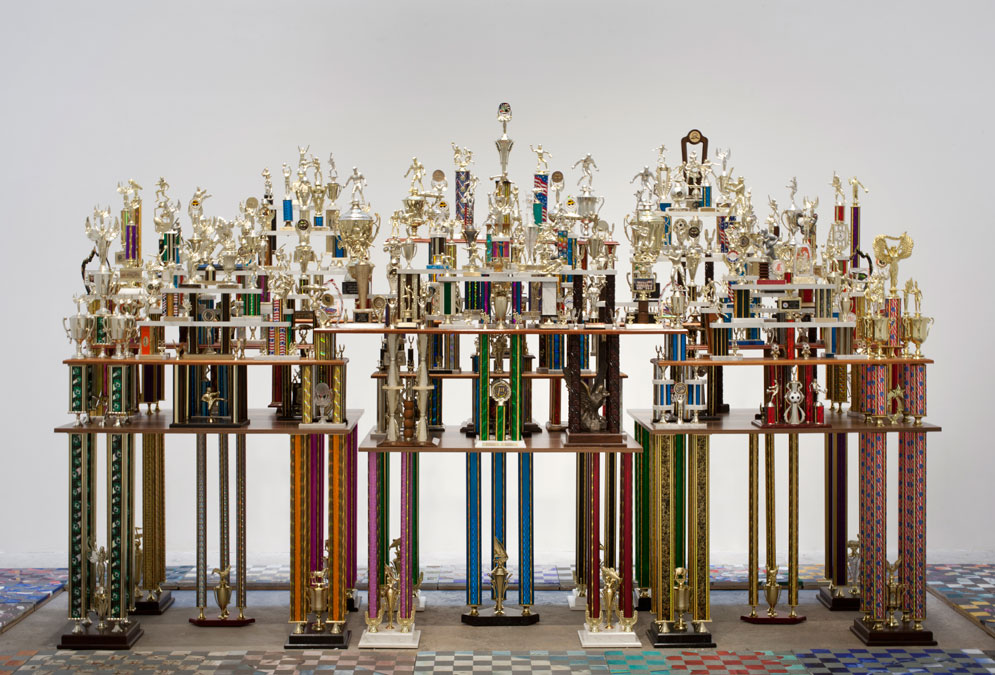
Second to None
Ry Rocklen has developed a language that is poetic and unique. His originality is an accomplishment considering the thousands of artists who used found objects in their work. Ry inserts old objects with his artistic mojo, giving them new life in a different realm. Perhaps you caught his previous outings in New York City at Marc Jancou in 2009 or in the Whitney Biennial of 2008. Rocklen’s latest New York show is up at Untitled on the Lower East Side until October 16th. Continue Reading More »
Comments closed
by Lee Foley
on October 4th, 2011

Installation View, The Murder of Hi Good, 2011
“The Murder of Hi Good” is Lee Lynch’s first solo exhibition at Steve Turner Contemporary. The focus of the exhibition is a video that plays on a loop, in an installation that makes you feel as if you are part of an early-American Freemason convention. In a narrative format, “The Murder of Hi Good,” contributes to a revisionist history of the American west, at the same time inviting the viewer into a performance that contemplates the use of historical references and objects in contemporary visual art.
Comments closed
by Aaron Harbour
on August 30th, 2011
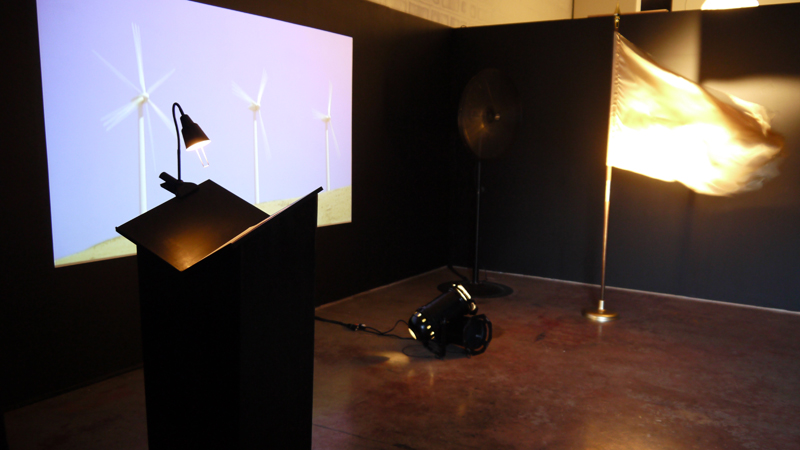
My fellow Americans. As a young boy, I dreamed of being a baseball, but tonight I say, we must move forward, not backward, upward not forward, and always twirling, twirling, twirling towards freedom.’- Kodos, Treehouse of Horror VII
‘…truth and…wonder in this country. For…energy and…inaction…love to move forward to…the exact same spot. In the end…time…needs all of you to deliver…the future.’- Excerpt from text edited from a presidential speech, part of Lauren Marsden’s Set for an Altered State, 2011
A tying off of sorts for her (productive) time spent in California, Set for an Altered State at Sight School in Oakland is Lauren Marsden’s first solo installation. The installation is a well conceived set of objects comprising a single, complete, immersive work. A cast off swim suit and sash of Miss Department of Energy (one of Marsden’s characters) sit in a pile of sand with a souvenir postcard of a de-ribbon cutting at a nuclear site decommissioning sits off to the side. There is a lectern with a remixed presidential speech (mashing power/energy, patriotism, and unity), a glitchy projection of idyllic wind turbines before a super blue sky, a pair of stage lights on the floor, and a , loud industrial fan activating a large, impossibly beautiful golden flag which emphatically flutters- all situated in the flat black gallery.
Continue Reading More »
Comments closed
by Cielo Lutino
on August 11th, 2011
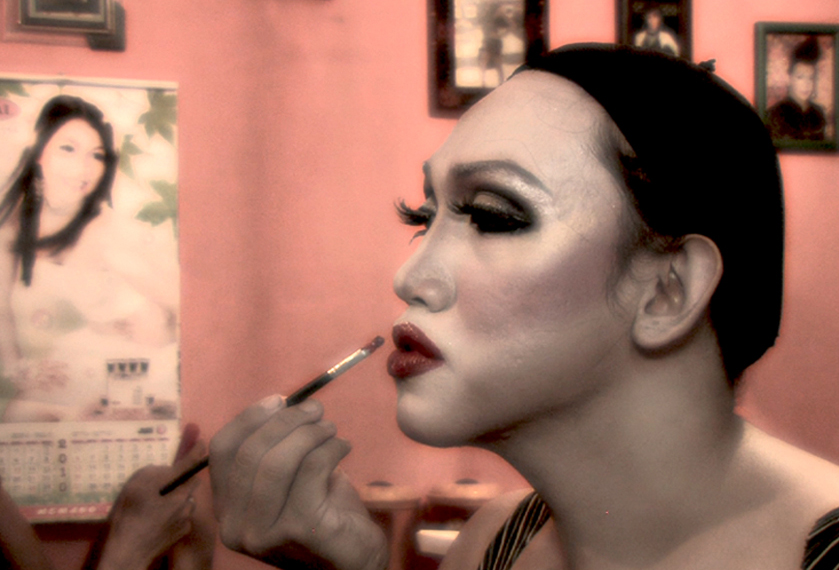
Tiara, one of the film's main characters, applies make-up. Photograph by Kathy Huang.
I know very little about Islam, not much more about Indonesia, and absolutely nothing about being transgendered. These shortcomings didn’t prevent me from relating to Tales of the Waria, however, Kathy Huang’s documentary about four transgendered women in Indonesia, home to the world’s largest Muslim population. Filmed in the cinematic coastal region of South Sulawesi, this sumptuously shot narrative follows four waria — a mash-up of wanita, which means woman, and pria, which means man — in their respective quests for love. Continue Reading More »
Comments closed








 RSS
RSS